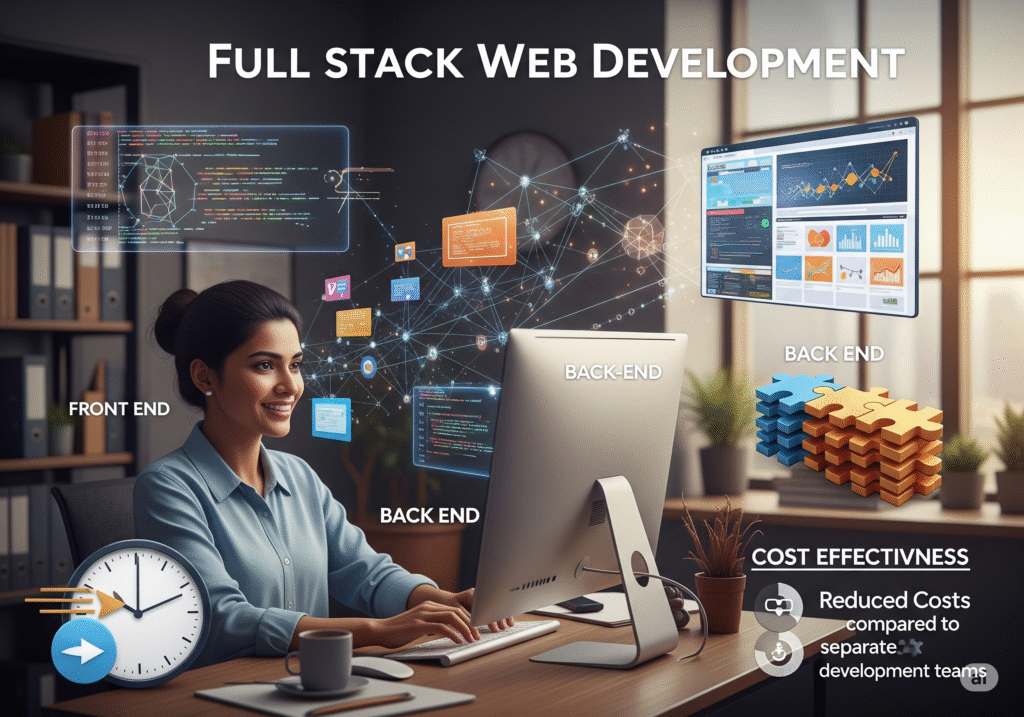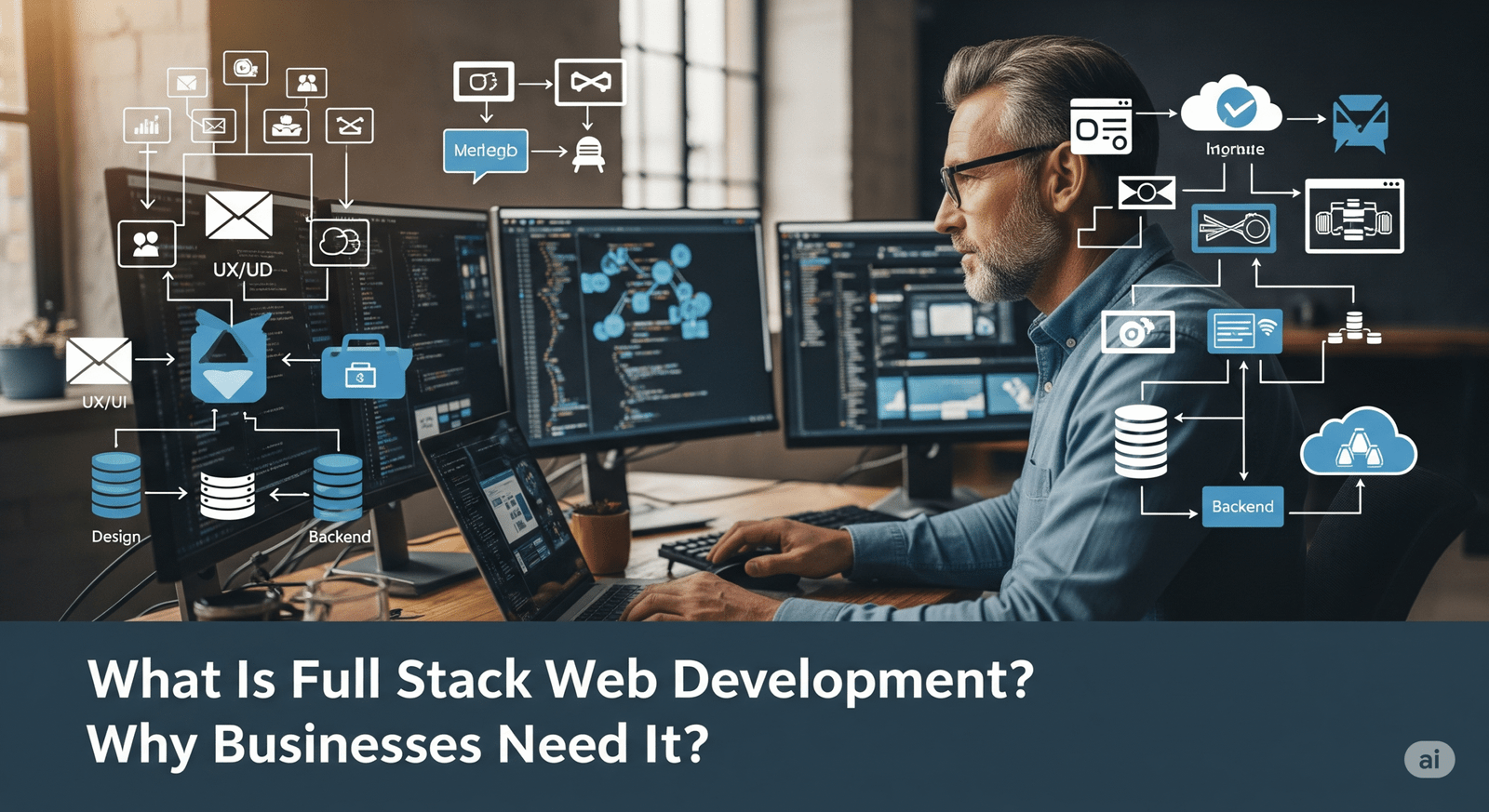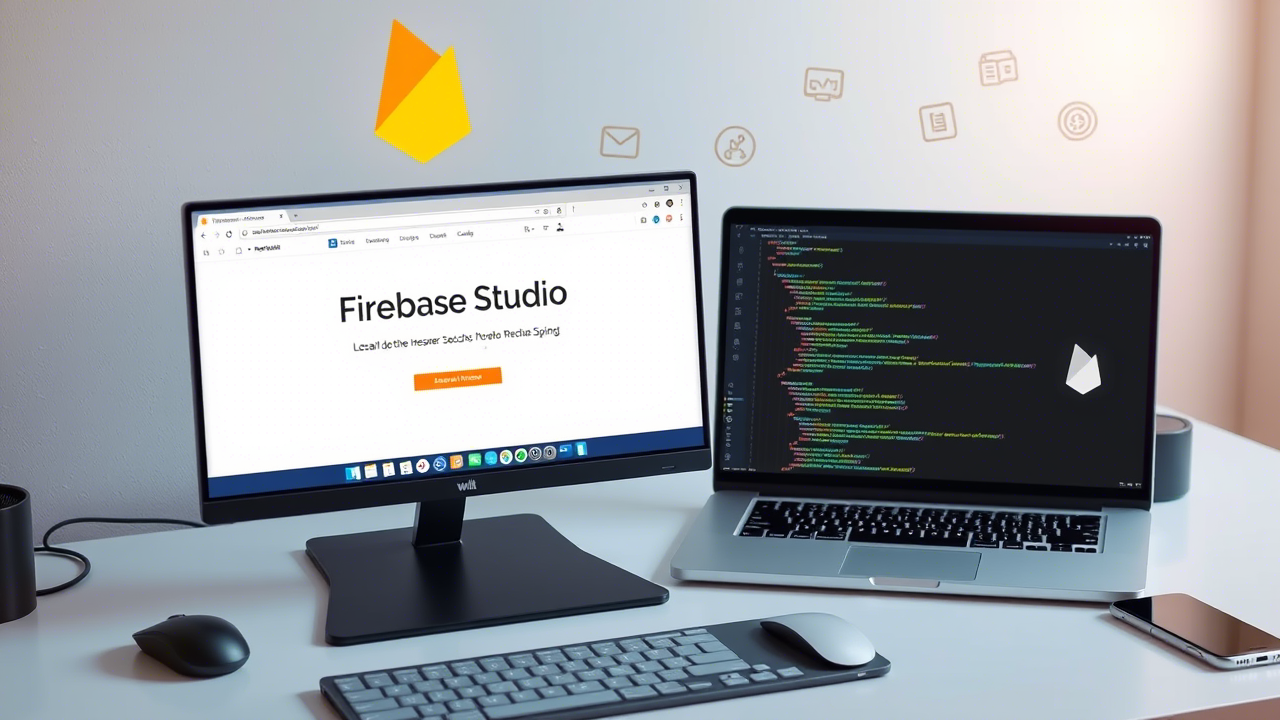What Is Full Stack Web Development? Why Businesses Need It?
Full Stack Web Development? Picture this: you’re building your dream car and need someone who can craft both the sleek exterior design and fine-tune the complex engine mechanics. That’s essentially what Full Stack Web Development brings to your business – a comprehensive solution that handles everything from user interface to server management.
In today’s competitive digital landscape, businesses are discovering that Full Stack Web Development isn’t just a trendy buzzword – it’s a strategic advantage that can transform how you build, deploy, and scale your web applications.
Table of Contents
Understanding Full Stack Web Development
Full Stack Web Development is like having a master chef who can prepare every component of a gourmet meal. Just as that burger has visible layers (the bun, lettuce, and toppings) and hidden elements (the special sauce and cooking technique), web applications have frontend and backend components.
The frontend represents everything users see and interact with – think HTML, CSS, JavaScript, and frameworks like React or Angular. The backend powers everything behind the scenes, including server logic, databases, and APIs using technologies like Node.js, Python, or Ruby on Rails.
A full stack developer masters both domains, creating seamless connections between user experience and server functionality. They’re the versatile professionals who can take your business concept and transform it into a fully functional, scalable web application.
What Makes Full Stack Development Special?
Unlike specialized developers who focus on either frontend or backend, full stack developers understand the complete web development ecosystem. They can:
- Design intuitive user interfaces
- Implement complex server-side logic
- Manage databases and data flow
- Handle deployment and scaling
- Integrate third-party services and APIs
This comprehensive skill set makes Full Stack Web Development particularly valuable for businesses seeking efficient, cohesive digital solutions.
Core Benefits of Full Stack Web Development

1. Significant Cost Efficiency
Why hire separate frontend and backend developers when one skilled professional can handle both? Full Stack Web Development dramatically reduces your development costs by consolidating roles without compromising quality.
Traditional development teams might require:
- Frontend developer ($70,000-$120,000 annually)
- Backend developer ($75,000-$130,000 annually)
- DevOps engineer ($80,000-$140,000 annually)
A skilled full stack developer can perform all these functions, delivering substantial cost savings while maintaining high development standards.
2. Accelerated Time-to-Market
Speed matters in today’s business environment. Full Stack Web Development eliminates the coordination delays that typically occur between separate frontend and backend teams.
With unified development processes, businesses experience:
- Faster iteration cycles
- Reduced communication overhead
- Streamlined debugging and testing
- Quicker deployment timelines
3. Enhanced Flexibility and Scalability
Business requirements evolve rapidly, and your development approach should adapt accordingly. Full stack developers provide the agility to pivot technologies, modify architectures, and scale applications as your user base grows.
This flexibility proves invaluable when:
- Adding new features mid-development
- Integrating with emerging technologies
- Scaling infrastructure for increased traffic
- Adapting to changing market demands
4. Improved Communication and Project Cohesion
Full Stack Web Development eliminates the “telephone game” effect that often occurs in larger development teams. With fewer handoffs between specialists, projects maintain consistency and alignment with your original vision.
Common Business Challenges Full Stack Development Solves
Breaking Down Development Silos
Many businesses struggle with disconnected development teams where frontend and backend developers work in isolation. This separation often leads to:
- Miscommunication about requirements
- Inconsistent user experience
- Integration problems during deployment
- Delayed project timelines
Full Stack Web Development bridges these gaps by ensuring one developer or unified team understands both client-side and server-side requirements.
Reducing Operational Complexity
Managing multiple specialized contractors or employees creates administrative overhead. Full stack development simplifies your operational structure by consolidating expertise into fewer, more versatile team members.
Maintaining Consistent Product Vision
When multiple developers each own different application layers, the overall product vision can become fragmented. Full stack developers maintain the big picture perspective, ensuring all components work harmoniously toward your business objectives.
Streamlining Maintenance and Updates
As your application grows, implementing updates shouldn’t require coordinating multiple specialists. Full Stack Web Development provides consistent code architecture and simplified maintenance processes, making future enhancements more manageable.
When Should Your Business Choose Full Stack Development?

Startups and Small Businesses
Resource constraints make Full Stack Web Development particularly attractive for startups. With limited budgets and aggressive timelines, having versatile developers who can build complete applications provides significant advantages.
Successful startups like Airbnb and Instagram initially relied on small, full stack teams to rapidly develop and iterate their platforms.
Rapid Prototyping Projects
Need to validate a business concept quickly? Full stack developers can create functional prototypes in days rather than weeks, allowing you to test market viability and gather user feedback efficiently.
Projects with Evolving Requirements
Some applications grow and change significantly during development. Full Stack Web Development provides the flexibility to adapt technologies, modify architectures, and pivot directions without rebuilding from scratch.
Applications Requiring End-to-End Ownership
Complex projects benefit from having developers who understand the entire application stack. This comprehensive ownership ensures nothing falls through the cracks and all components integrate seamlessly.
Best Practices for Implementing Full Stack Development
Hiring the Right Talent
Successful Full Stack Web Development depends on finding developers with the right combination of technical skills and problem-solving abilities. Key qualifications include:
Frontend Expertise:
- HTML5, CSS3, JavaScript (ES6+)
- Modern frameworks (React, Vue.js, Angular)
- Responsive design principles
- User experience fundamentals
Backend Proficiency:
- Server-side languages (Node.js, Python, Ruby, PHP)
- Database management (SQL, NoSQL, MongoDB, PostgreSQL)
- API design and integration
- Cloud services and deployment
Development Tools:
- Version control systems (Git)
- Testing frameworks and methodologies
- DevOps and CI/CD pipelines
- Agile development practices
Choosing the Right Technology Stack
Your technology stack selection significantly impacts long-term success. Popular Full Stack Web Development combinations include:
MEAN Stack (MongoDB, Express.js, Angular, Node.js)
- Excellent for real-time applications
- JavaScript across the entire stack
- Strong community support
MERN Stack (MongoDB, Express.js, React, Node.js)
- Highly flexible and component-based
- Excellent for interactive user interfaces
- Popular among modern web applications
LAMP Stack (Linux, Apache, MySQL, PHP)
- Proven reliability and stability
- Extensive documentation and resources
- Cost-effective for traditional web applications
At YAAM Web Solutions, we help businesses select the optimal technology stack based on their specific requirements, scalability needs, and long-term objectives.

Implementing Efficient Development Workflows
Full Stack Web Development succeeds with well-defined processes and workflows:
Agile Methodology: Implement sprint-based development with regular stakeholder feedback and iterative improvements.
Version Control: Use Git for collaborative development and maintain clean, documented code repositories.
Continuous Integration/Continuous Deployment (CI/CD): Automate testing and deployment processes to ensure code quality and reduce manual errors.
Quality Assurance: Implement comprehensive testing strategies including unit tests, integration tests, and user acceptance testing.
Quality Assurance and Testing Strategies
Robust testing ensures your Full Stack Web Development project delivers reliable, bug-free applications:
Automated Testing Tools:
- Jest for JavaScript unit testing
- Selenium for browser automation
- Postman for API testing
- Cypress for end-to-end testing
Testing Best Practices:
- Write tests alongside development code
- Implement both frontend and backend testing
- Use continuous integration for automated test execution
- Perform regular security audits and performance testing
How YAAM Web Solutions Can Transform Your Business
Understanding Full Stack Web Development is just the beginning – successful implementation requires experienced partners who can navigate complex technical challenges while keeping your business objectives in focus.
YAAM Web Solutions specializes in delivering comprehensive full stack development services that align with your strategic goals. Our experienced team combines technical expertise with business acumen to create scalable, high-performance web applications.
Our Full Stack Development Services Include:
Custom Web Application Development: From concept to deployment, we build tailored solutions that address your unique business requirements.
MVP Development: Rapidly prototype and validate your ideas with lean, functional applications that can evolve with your business.
Legacy System Modernization: Transform outdated applications using modern full stack technologies while preserving critical business functionality.
E-commerce Solutions: Create robust online stores with seamless user experiences and powerful backend management systems.
API Development and Integration: Connect your applications with third-party services and create scalable microservices architectures.
Why Choose YAAM Web Solutions?
Proven Expertise: Our team has successfully delivered full stack projects across diverse industries, from startups to enterprise organizations.
Technology Agnostic: We select the best technology stack for your specific needs rather than forcing one-size-fits-all solutions.
Collaborative Approach: We work closely with your team throughout the development process, ensuring alignment with your vision and objectives.
Quality Assurance: Rigorous testing and quality control processes ensure your application performs reliably under real-world conditions.
Ongoing Support: Our relationship doesn’t end at deployment – we provide maintenance, updates, and scaling support as your business grows.
Ready to leverage Full Stack Web Development for your business? Contact YAAM Web Solutions today to discuss how we can transform your digital presence with comprehensive, scalable web solutions.
Frequently Asked Questions
What is Full Stack Web Development?
Full Stack Web Development involves creating both the frontend (user interface) and backend (server, database, and logic) components of web applications. Full stack developers possess the skills to work across the entire technology stack, from user experience design to server management and database optimization.
What technologies do full stack developers work with?
Full stack developers typically work with a diverse range of technologies including:
- Frontend: HTML, CSS, JavaScript, React, Angular, Vue.js
- Backend: Node.js, Python, Ruby on Rails, PHP, Java
- Databases: MySQL, PostgreSQL, MongoDB, Redis
- Tools: Git, Docker, AWS, CI/CD pipelines
Can a full stack developer create a complete mobile app?
Yes, full stack developers can create mobile applications using cross-platform frameworks like React Native, Flutter, or Ionic. These technologies allow developers to use their web development skills to build mobile apps that work on both iOS and Android platforms.
What is the difference between full stack development and specialized development?
Specialized developers focus on either frontend or backend development, becoming experts in their specific domain. Full stack developers have broader knowledge across multiple technologies, making them versatile but potentially less specialized in any single area. The choice depends on project complexity, budget, and timeline requirements.
How much does Full Stack Web Development cost?
Full Stack Web Development costs vary significantly based on project complexity, features, and timeline. Simple applications might cost $10,000-$50,000, while complex enterprise solutions can range from $100,000-$500,000 or more. Contact YAAM Web Solutions for a detailed project estimate based on your specific requirements.
Is Full Stack Web Development suitable for large enterprises?
Absolutely. Many large enterprises successfully use full stack development for specific projects, especially when rapid prototyping, MVP development, or streamlined maintenance is required. However, complex enterprise applications might benefit from specialized teams for certain components while maintaining full stack oversight for integration and coordination.
Ready to harness the power of Full Stack Web Development for your business? YAAM Web Solutions combines technical expertise with strategic thinking to deliver web applications that drive business growth. Contact us today to start your digital transformation journey.







